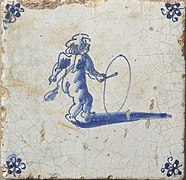Japanese Folk Art Museum
The Museum of Japanese Folk Art ( Japanese 日本 民 芸 館 , Nihon mingei-kan, own spelling with old Kanji : 日本 民 藝 館 ) in Tokyo collects and shows as a foundation under public law (kōeki zaidan hōjin) Japanese and exemplary foreign folk art. The museum is located on the southwest corner of the Komaba Park in the district Komaba the district Meguro of Tokyo .
history
Yanagi Muneyoshi and his colleagues planned a museum of folk art, an idea that was financially supported by the entrepreneur and patron Ōhara Magosaburō . The "Museum of Japanese Folk Art" was opened in October 1936. The museum consists of a traditional two-storey clapboard-covered building, an exhibition building, a reinforced concrete storage building and a building called the “west building” on the opposite side of the street, which is covered with stone bricks.
The peculiarity of the museum is that it shows a selection of beautiful folk art and craft items, and it does so comprehensively
- Japan (ceramics, textiles, handicrafts, pictures, other folk art, Okinawa , Ainu )
- Korea (porcelain, handicrafts, pictures, other folk art)
- Taiwan, China and Europe
The museum also shows pieces by artists of the 20th century who worked in a folk art style, namely: Bernard Leach , Kawai Kanjirō , Hamada Shōji , Serizawa Keisuke and Munakata Shikō . - The collection of more than 20,000 pieces is shown in parts over the course of a year.
The exhibition area in the two-story main building comprises 588 m², plus 300 m² of storage space and a further 26 m², for a total of 914 m². Yanagi designed the museum himself, he also became the first director.
The museum publishes the monthly magazine Mingei .
Exemplary pieces from the collection
-
Ceramic : "Gradient painted tea vessel" (流 彩 茶壺 ・ 小 代, Chatsubo - Shōdai) from the Edo period ;
- " Slipware " from England, 18th century;
-
Porcelain : " Imari painted with a landscape " (染 付 山水 文 大 鉢 伊万 里, Sometsuke sansui-mon ōhachi Imari) from the beginning of the Edo period;
- "Vessel painted rust-colored with grapes" (鉄 砂 染 付 葡萄 文 壺, Tessa sometsuki budō-mon tsubo), Korean, Middle Joseon Dynasty ;
- Lacquerware : "Lacquer vessel painted with gold and silver" (箔 絵 漆 椀 (秀 衡 椀, Hakue-e urushi-wan), Iwate Prefecture , Edo period;
-
Textiles : “Garment decorated with falling geese against distant mountains on a blue background” ((水色 遠山 に 落雁 文 様 紅 型 衣裳, Mizuiro jitōyama ni rakugan monjōbin-gata ishō), Okinawa , Edo period;
- "Fine-Woven Kimono" (手 縞 着 物 ・ 沖 縄, Tejima kimono), Okinawa, 19th century;
- “Decorated upper garment” (切 伏 衣裳, Kirefuse ishō), Hokkaidō , 19th century;
- Wood craft : "Self-portrait of the priest Mokujiki" (木 喰 上人 自 刻 像, Mokujiki jōnin jikoku-zō), Edo period;
- Metalwork : "Cast iron kettle for the tea ceremony" (鬼霰釜, Oniarare-gama) from Yamagata Prefecture ;
Pictures in the collection
Role model ( Ema )
Remarks
- ↑ The designation Shōdai or Shōdai-yaki refers to the kilns at the foot of the Shōdai mountain on the outskirts of Tamana in the Kumamoto prefecture .
- ↑ priests Mokujiki Myōman (木喰明満) lived 1718-1810.
- ↑ Kasumigaseki in Tokyo as "clay picture" (泥 絵, Doro-e).
literature
- S. Noma (Ed.): Japan Folk-Craft Museum . In: Japan. An Illustrated Encyclopedia. Kodansha, 1993, ISBN 4-06-205938-X
- Tōkyō hakubutsukan kyōgikai (Ed.): Nihon mingeikan . In: Tōkyō no hakubutsukan (Museums in Tokyo). 17th edition 1990.
- Ōshita, Atsushi (Ed.): Nihon mingeikan . In: Zenkoku bijutsujan gaido. (Art Museums in Japan) Tokyo, 1981.
Web links
Coordinates: 35 ° 39 ′ 39 ″ N , 139 ° 40 ′ 45 ″ E






